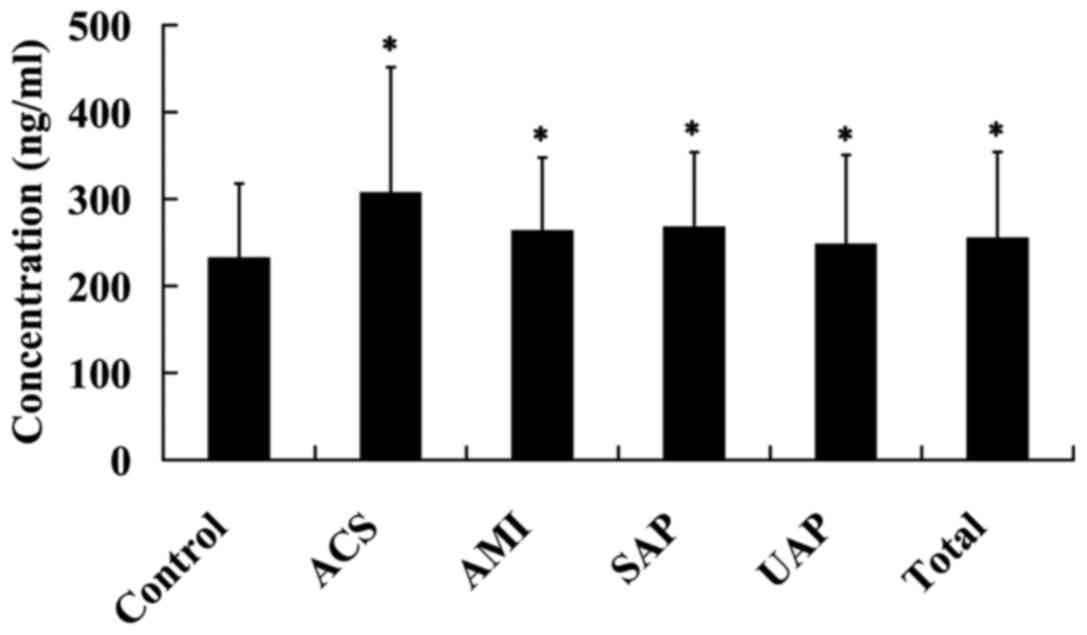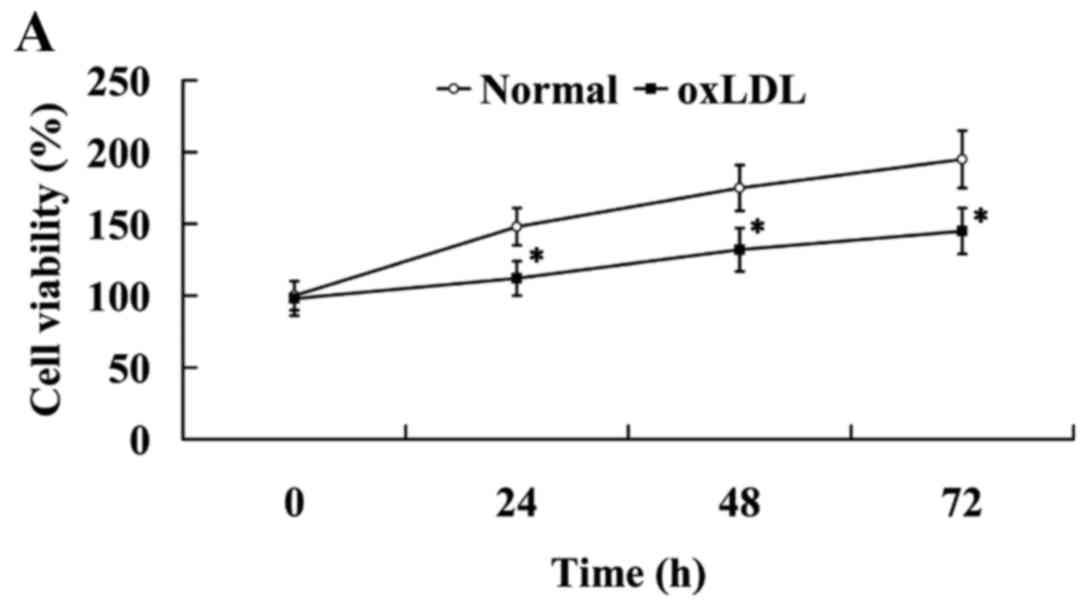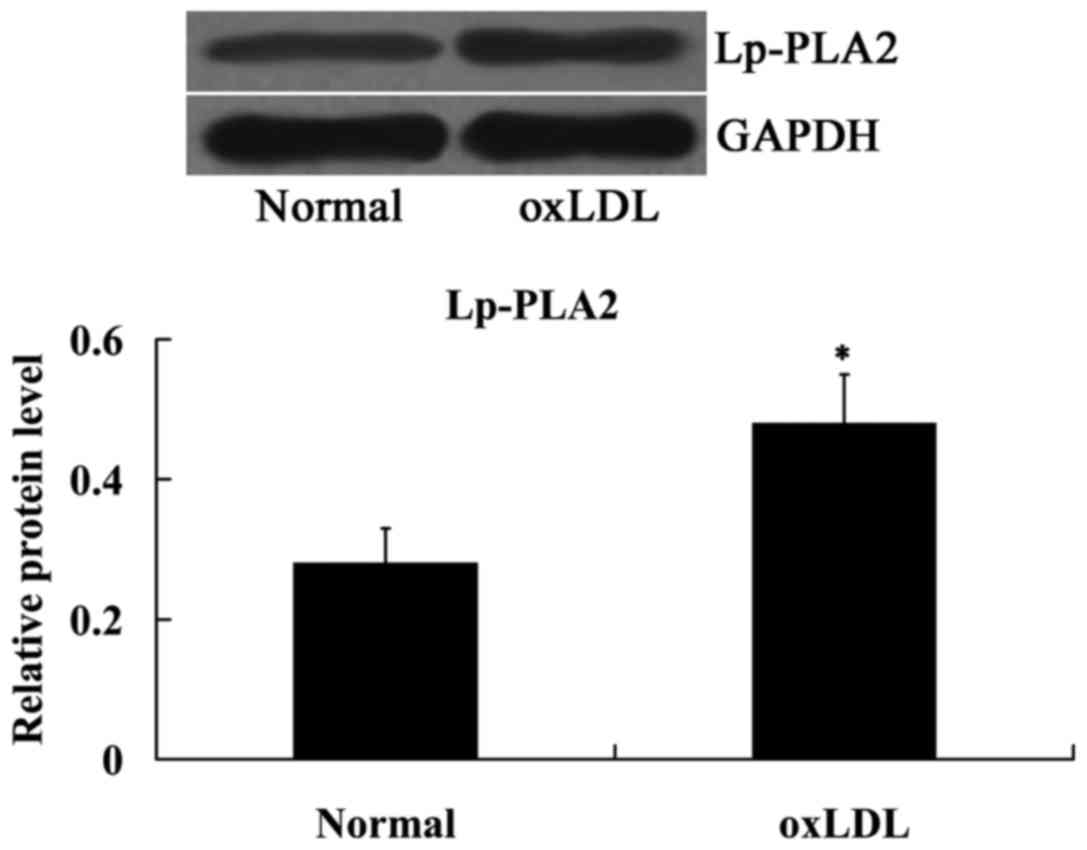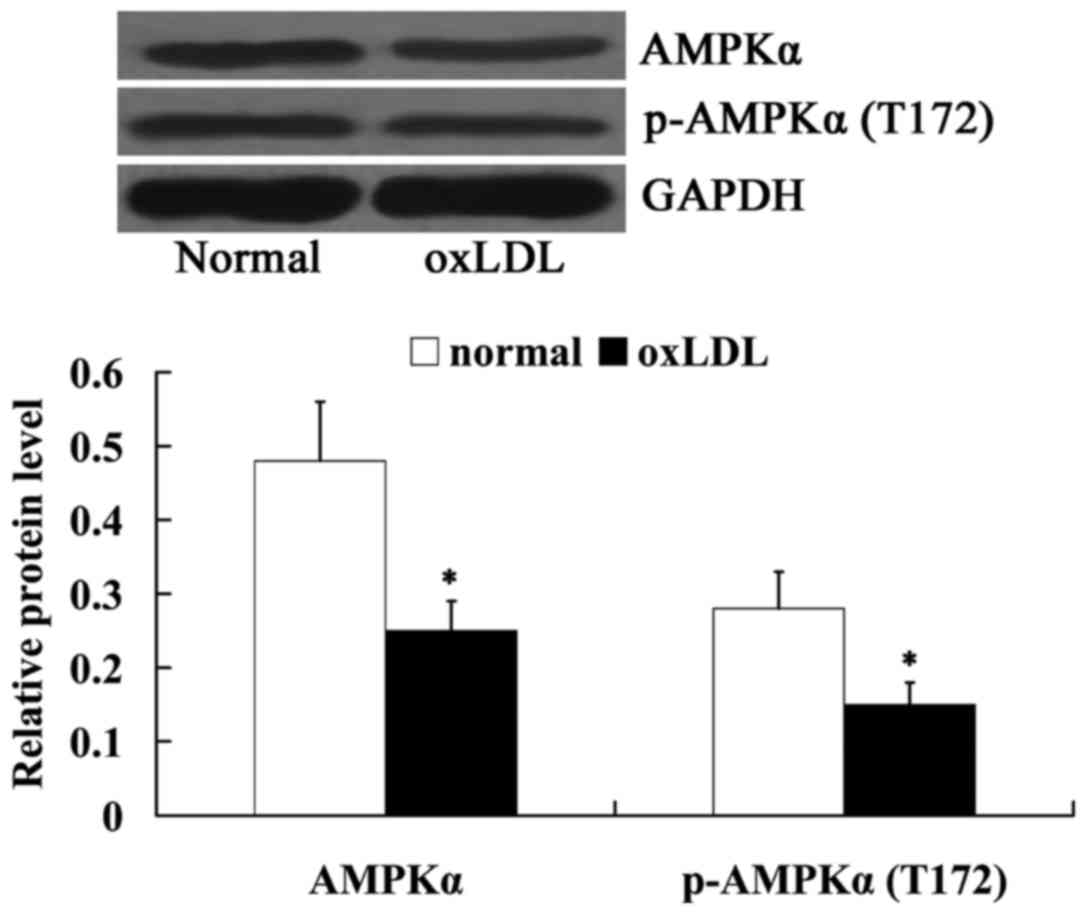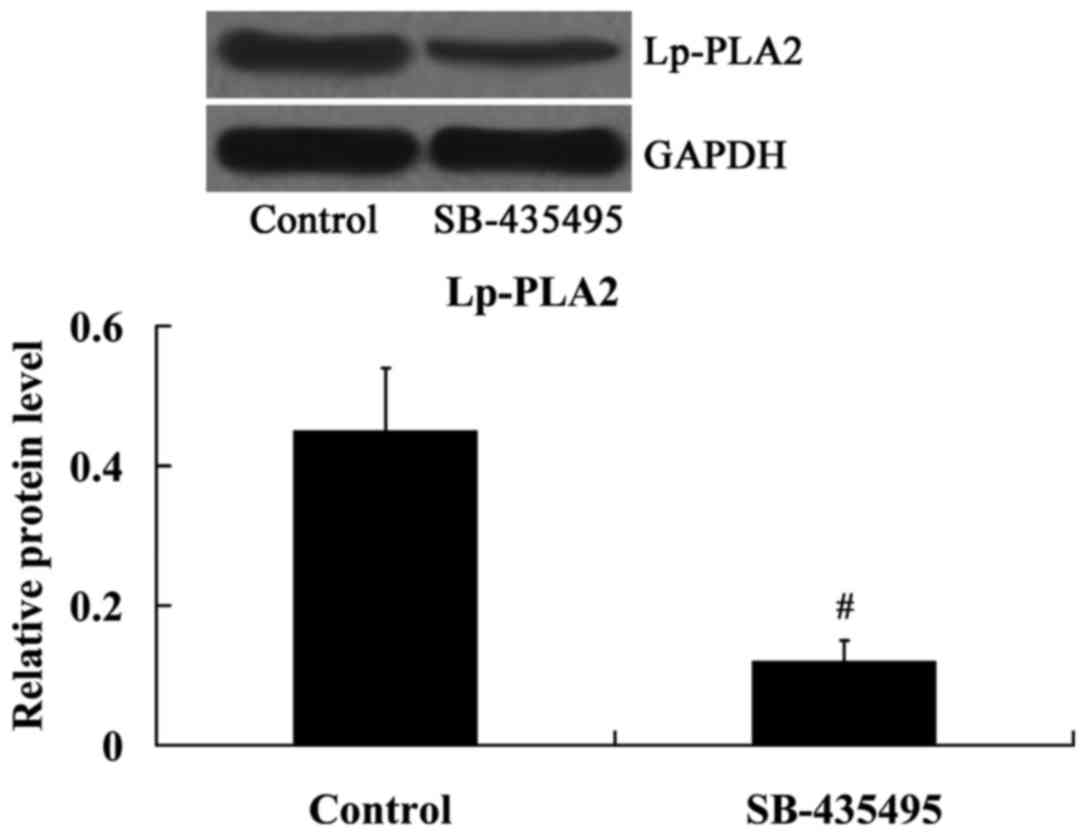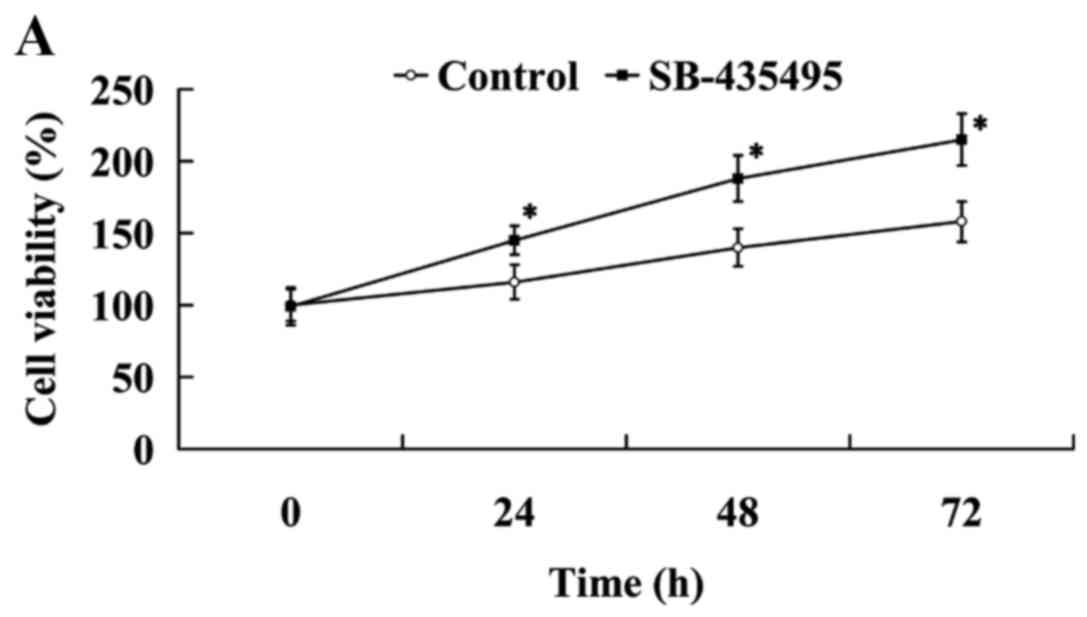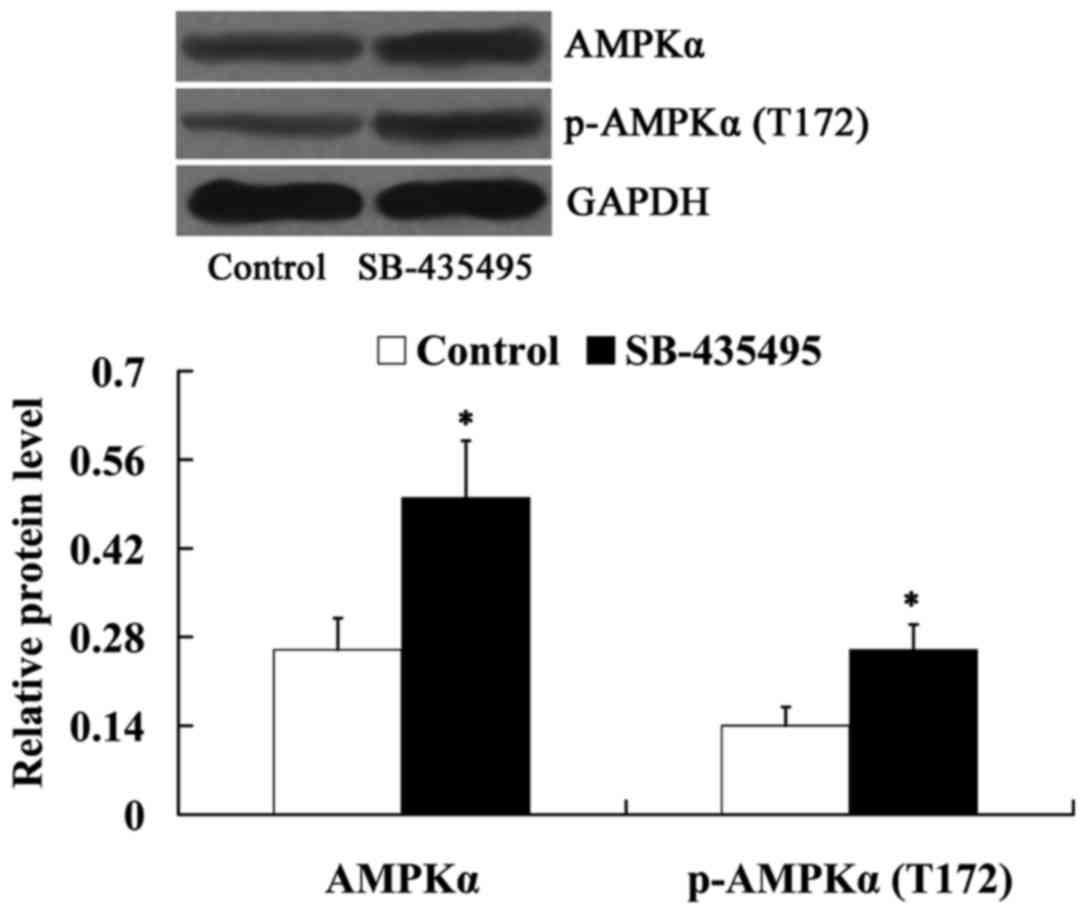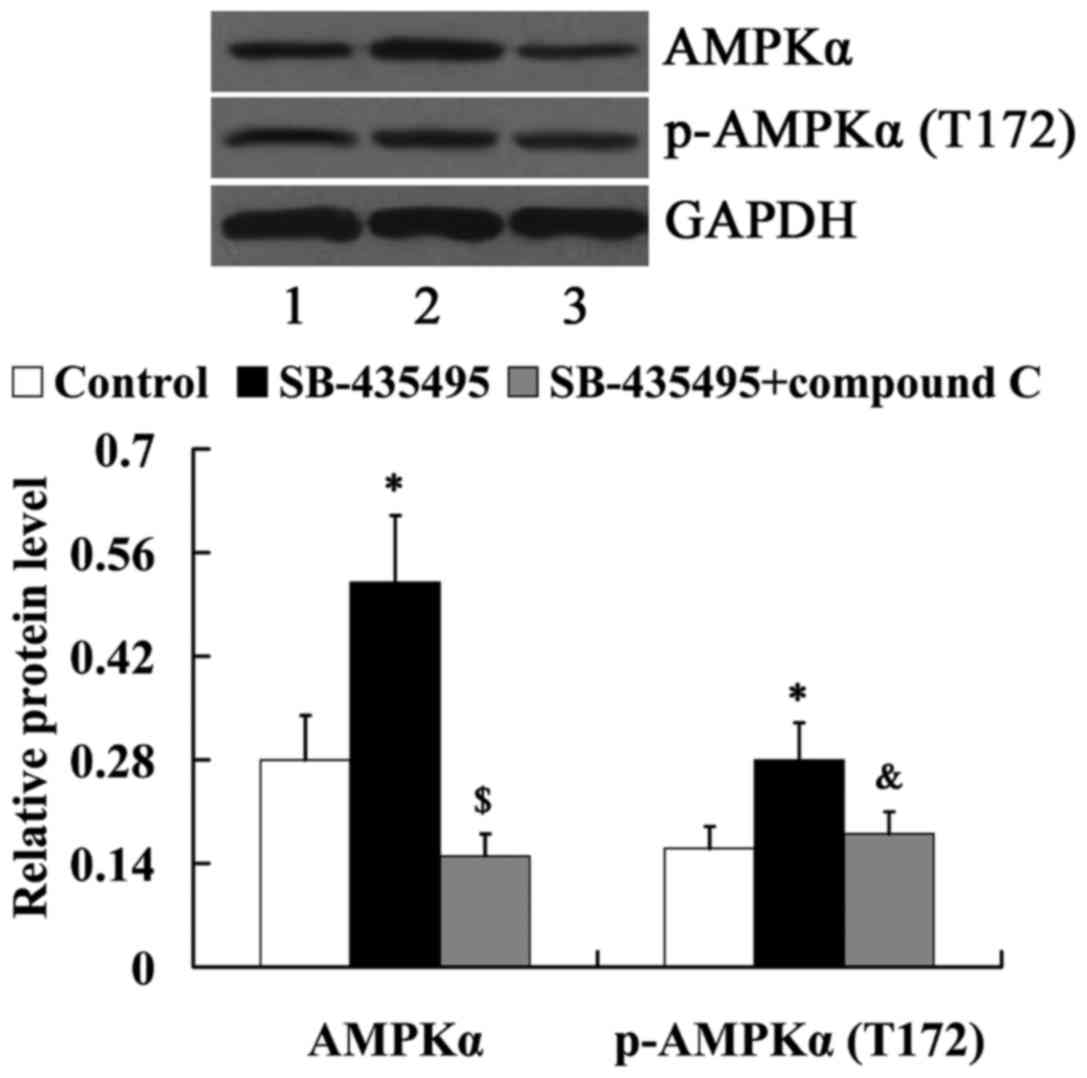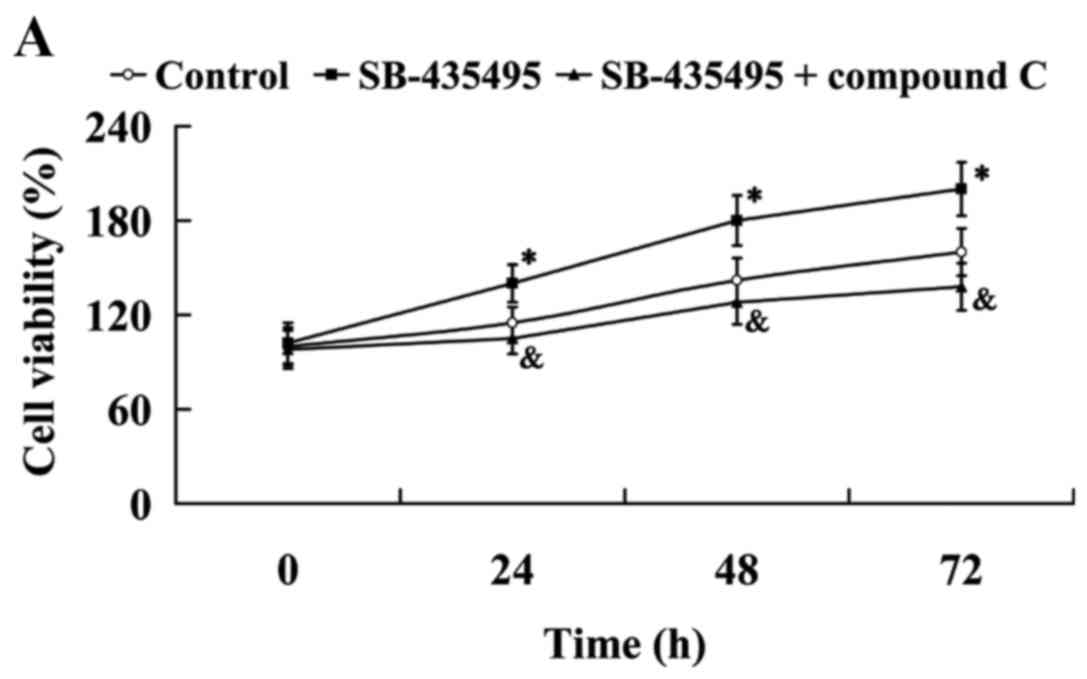|
1
|
Leys D: Atherothrombosis: A major health
burden. Cerebrovasc Dis. 11 Suppl 2:S1–S4. 2011. View Article : Google Scholar
|
|
2
|
Galkina E and Ley K: Immune and
inflammatory mechanisms of atherosclerosis (*). Annu Rev Immunol.
27:165–197. 2009. View Article : Google Scholar : PubMed/NCBI
|
|
3
|
Ross R: Atherosclerosis-an inflammatory
disease. N Engl J Med. 340:115–126. 1999. View Article : Google Scholar : PubMed/NCBI
|
|
4
|
Eskin SG, Ives CL, McIntire LV and Navarro
LT: Response of cultured endothelial cells to steady flow.
Microvasc Res. 28:87–94. 1984. View Article : Google Scholar : PubMed/NCBI
|
|
5
|
Langille BL and Adamson SL: Relationship
between blood flow direction and endothelial cell orientation at
arterial branch sites in rabbits and mice. Circ Res. 48:481–488.
1981. View Article : Google Scholar : PubMed/NCBI
|
|
6
|
Bonetti PO, Lerman LO and Lerman A:
Endothelial dysfunction: A marker of atherosclerotic risk.
Arterioscler Thromb Vasc Biol. 23:168–175. 2003. View Article : Google Scholar : PubMed/NCBI
|
|
7
|
Karabina SA and Ninio E: Plasma
PAF-acetylhydrolase: An unfulfilled promise? Biochim Biophys Acta.
1761:1351–1358. 2006. View Article : Google Scholar : PubMed/NCBI
|
|
8
|
Venable ME, Zimmerman GA, McIntyre TM and
Prescott SM: Platelet-activating factor: A phospholipid autacoids
with diverse actions. J Lipid Res. 34:691–702. 1993.PubMed/NCBI
|
|
9
|
Snyder F: Platelet-activating factor and
its analogs: Metabolic pathways and related intracellular
processes. Biochim Biophys Acta. 1254:231–249. 1995. View Article : Google Scholar : PubMed/NCBI
|
|
10
|
Yang EH, McConnell JP, Lennon RJ, Barsness
GW, Pumper G, Hartman SJ, Rihal CS, Lerman LO and Lerman A:
Lipoprotein-associated phospholipase A2 is an independent marker
for coronary endothelial dysfunction in humans. Arterioscler Thromb
Vasc Biol. 26:106–111. 2006. View Article : Google Scholar : PubMed/NCBI
|
|
11
|
Lavi S, McConnell JP, Rihal CS, Prasad A,
Mathew V, Lerman LO and Lerman A: Local production of
lipoprotein-associated phospholipase A2 and lysophosphatidylcholine
in the coronary circulation: Association with early coronary
atherosclerosis and endothelial dysfunction in humans. Circulation.
115:2715–2721. 2007. View Article : Google Scholar : PubMed/NCBI
|
|
12
|
Hardie DG: AMPK and raptor: Matching cell
growth to energy supply. Mol Cell. 30:263–265. 2008. View Article : Google Scholar : PubMed/NCBI
|
|
13
|
Zou MH, Hou XY, Shi CM, Kirkpatick S, Liu
F, Goldman MH and Cohen RA: Activation of 5′-AMP-activated kinase
is mediated through c-Src and phosphoinositide 3-kinase activity
during hypoxia-reoxygenation of bovine aortic endothelial cells.
Role of peroxynitrite. J Biol Chem. 278:34003–34010. 2003.
View Article : Google Scholar : PubMed/NCBI
|
|
14
|
Suzuki K, Uchida K, Nakanishi N and
Hattori Y: Cilostazol activates AMP-activated protein kinase and
restores endothelial function in diabetes. Am J Hypertens.
21:451–457. 2008. View Article : Google Scholar : PubMed/NCBI
|
|
15
|
Hombach V, Höher M, Kochs M, Eggeling T,
Schmidt A, Höpp HW and Hilger HH: Pathophysiology of unstable
angina pectoris-correlations with coronary angioscopic imaging. Eur
Heart J. 9 Suppl N:40–45. 1988. View Article : Google Scholar : PubMed/NCBI
|
|
16
|
Plutzky J: Inflammatory pathways in
atherosclerosis and acute coronary syndromes. Am J Cardiol.
88:10K–15K. 2001. View Article : Google Scholar : PubMed/NCBI
|
|
17
|
Tsujita K, Kaikita K, Soejima H, Sugiyama
S and Ogawa H: Acute coronary syndrome-initiating factors. Nihon
Rinsho. 68:607–614. 2010.(In Japanese). PubMed/NCBI
|
|
18
|
Dohi T and Daida H: Change of concept and
pathophysiology in acute coronary syndrome. Nihon Rinsho.
68:592–596. 2010.(In Japanese). PubMed/NCBI
|
|
19
|
Khuseyinova N, Imhof A, Rothenbacher D,
Trischler G, Kuelb S, Scharnagl H, Maerz W, Brenner H and Koenig W:
Association between Lp-PLA2 and coronary artery disease: Focus on
its relationship with lipoproteins and markers of inflammation and
hemostasis. Atherosclerosis. 182:181–188. 2005. View Article : Google Scholar : PubMed/NCBI
|
|
20
|
Steinberg D: Low density lipoprotein
oxidation and its pathobiological significance. J Biol Chem.
272:20963–20966. 1997. View Article : Google Scholar : PubMed/NCBI
|
|
21
|
Ryu JH, Yu M, Lee S, Ryu DR, Kim SJ, Kang
DH and Choi KB: AST-120 improves microvascular endothelial
dysfunction in end-stage renal disease patients receiving
hemodialysis. Yonsei Med J. 57:942–949. 2016. View Article : Google Scholar : PubMed/NCBI
|
|
22
|
Ceriello A, De Nigris V, Pujadas G, La
Sala L, Bonfigli AR, Testa R, Uccellatore A and Genovese S: The
simultaneous control of hyperglycemia and GLP-1 infusion normalize
endothelial function in type 1 diabetes. Diabetes Res Clin Pract.
114:64–68. 2016. View Article : Google Scholar : PubMed/NCBI
|
|
23
|
Deanfield J, Donald A, Ferri C,
Giannattasio C, Halcox J, Halligan S, Lerman A, Mancia G, Oliver
JJ, Pessina AC, et al: Endothelial function and dysfunction. Part
I: Methodological issues for assessment in the different vascular
beds: A statement by the working group on endothelin and
endothelial factors of the european society of hypertension. J
Hypertens. 23:7–17. 2005. View Article : Google Scholar : PubMed/NCBI
|
|
24
|
Gokce N, Keaney JF Jr, Hunter LM, Watkins
MT, Menzoian JO and Vita JA: Risk stratification for postoperative
cardiovascular events via noninvasive assessment of endothelial
function: A prospective study. Circulation. 105:1567–1572. 2002.
View Article : Google Scholar : PubMed/NCBI
|
|
25
|
Shah V, Toruner M, Haddad F, Cadelina G,
Papapetropoulos A, Choo K, Sessa WC and Groszmann RJ: Impaired
endothelial nitric oxide synthase activity associated with enhanced
caveolin binding in experimental cirrhosis in the rat.
Gastroenterology. 117:1222–1228. 1999. View Article : Google Scholar : PubMed/NCBI
|
|
26
|
Taguchi K, Matsumoto T and Kobayashi T:
G-protein-coupled receptor kinase 2 and endothelial dysfunction:
Molecular insights and pathophysiological mechanisms. J Smooth
Muscle Res. 51:37–49. 2015. View Article : Google Scholar : PubMed/NCBI
|
|
27
|
Böhm F and Pernow J: The importance of
endothelin-1 for vascular dysfunction in cardiovascular disease.
Cardiovasc Res. 76:8–18. 2007. View Article : Google Scholar : PubMed/NCBI
|
|
28
|
Tuttolomondo A, Di Raimondo D, Pecoraro R,
Arnao V, Pinto A and Licata G: Atherosclerosis as an inflammatory
disease. Curr Pharm Des. 18:4266–4288. 2012. View Article : Google Scholar : PubMed/NCBI
|
|
29
|
Lawson C and Wolf S: ICAM-1 signaling in
endothelial cells. Pharmacol Rep. 61:22–32. 2009. View Article : Google Scholar : PubMed/NCBI
|
|
30
|
Jackson DE: The unfolding tale of PECAM-1.
FEBS Lett. 540:7–14. 2003. View Article : Google Scholar : PubMed/NCBI
|
|
31
|
Albelda SM, Muller WA, Buck CA and Newman
PJ: Molecular and cellular properties of PECAM-1 (endoCAM/CD31): A
novel vascular cell-cell adhesion molecule. J Cell Biol.
114:1059–1068. 1991. View Article : Google Scholar : PubMed/NCBI
|
|
32
|
Collins RG, Velji R, Guevara NV, Hicks MJ,
Chan L and Beaudet AL: P-Selectin or intercellular adhesion
molecule (ICAM)-1 deficiency substantially protects against
atherosclerosis in apolipoprotein E-deficient mice. J Exp Med.
191:189–194. 2000. View Article : Google Scholar : PubMed/NCBI
|
|
33
|
Zibara K, Chignier E, Covacho C, Poston R,
Canard G, Hardy P and McGregor J: Modulation of expression of
endothelial intercellular adhesion molecule-1, platelet-endothelial
cell adhesion molecule-1, and vascular cell adhesion molecule-1 in
aortic arch lesions of apolipoprotein E-deficient compared with
wild-type mice. Arterioscler Thromb Vasc Biol. 20:2288–2296. 2000.
View Article : Google Scholar : PubMed/NCBI
|
|
34
|
Silva IT, Mello AP and Damasceno NR:
Antioxidant and inflammatory aspects of lipoprotein-associated
phospholipase A2 (Lp-PLA2): A review. Lipids Health Dis.
10:1702011. View Article : Google Scholar : PubMed/NCBI
|
|
35
|
Zalewski A and Macphee C: Role of
lipoprotein-associated phospholipase A2 in atherosclerosis:
Biology, epidemiology, and possible therapeutic target.
Arterioscler Thromb Vasc Biol. 25:923–931. 2005. View Article : Google Scholar : PubMed/NCBI
|
|
36
|
Häkkinen T, Luoma JS, Hiltunen MO, Macphee
CH, Milliner KJ, Patel L, Rice SQ, Tew DG, Karkola K and
Ylä-Herttuala S: Lipoprotein-associated phospholipase A(2),
platelet-activating factor acetylhydrolase, is expressed by
macrophages in human and rabbit atherosclerotic lesions.
Arterioscler Thromb Vasc Biol. 19:2909–2917. 1999. View Article : Google Scholar : PubMed/NCBI
|
|
37
|
Wang WY, Li J, Yang D, Xu W, Zha RP and
Wang YP: OxLDL stimulates lipoprotein-associated phospholipase A2
expression in THP-1 monocytes via PI3K and p38 MAPK pathways.
Cardiovasc Res. 85:845–852. 2010. View Article : Google Scholar : PubMed/NCBI
|
|
38
|
De Keyzer D, Karabina SA, Wei W, Geeraert
B, Stengel D, Marsillach J, Camps J, Holvoet P and Ninio E:
Increased PAFAH and oxidized lipids are associated with
inflammation and atherosclerosis in hypercholesterolemic pigs.
Arterioscler Thromb Vasc Biol. 29:2041–2046. 2009. View Article : Google Scholar : PubMed/NCBI
|
|
39
|
Pasini A Fratta, Stranieri C, Pasini A,
Vallerio P, Mozzini C, Solani E, Cominacini M, Cominacini L and
Garbin U: Lysophosphatidylcholine and carotid intima-media
thickness in young smokers: A role for oxidized LDL-induced
expression of PBMC lipoprotein-associated phospholipase A2? PLoS
One. 8:e830922013. View Article : Google Scholar : PubMed/NCBI
|
|
40
|
Zou MH and Wu Y: AMP-activated protein
kinase activation as a strategy for protecting vascular endothelial
function. Clin Exp Pharmacol Physiol. 35:535–545. 2000. View Article : Google Scholar
|
|
41
|
Li C: Genetics and molecular
biology-protein kinase C-zeta as an AMP-activated protein kinase
kinase kinase: The protein kinase C-zeta-LKB1-AMP-activated protein
kinase pathway. Curr Opin Lipidol. 19:541–542. 2008. View Article : Google Scholar : PubMed/NCBI
|
|
42
|
Hawley SA, Davison M, Woods A, Davies SP,
Beri RK, Carling D and Hardie DG: Characterization of the
AMP-activated protein kinase kinase from rat liver and
identification of threonine 172 as the major site at which it
phosphorylates AMP-activated protein kinase. J Biol Chem.
271:27879–27887. 1996. View Article : Google Scholar : PubMed/NCBI
|
|
43
|
Guo H, Chen Y, Liao L and Wu W:
Resveratrol protects HUVECs from oxidized-LDL induced oxidative
damage by autophagy upregulation via the AMPK/SIRT1 pathway.
Cardiovasc Drugs Ther. 27:189–198. 2013. View Article : Google Scholar : PubMed/NCBI
|
|
44
|
Morrow VA, Foufelle F, Connell JM, Petrie
JR, Gould GW and Salt IP: Direct activation of AMP-activated
protein kinase stimulates nitric-oxide synthesis in human aortic
endothelial cells. J Biol Chem. 278:31629–31639. 2003. View Article : Google Scholar : PubMed/NCBI
|
|
45
|
Reiter CE, Kim JA and Quon MJ: Green tea
polyphenol epigallocatechin gallate reduces endothelin-1 expression
and secretion in vascular endothelial cells: Roles for
AMP-activated protein kinase, Akt, and FOXO1. Endocrinology.
151:103–114. 2010. View Article : Google Scholar : PubMed/NCBI
|
|
46
|
Cacicedo JM, Yagihashi N, Keaney JF Jr,
Ruderman NB and Ido Y: AMPK inhibits fatty acid-induced increases
in NF-kappaB transactivation in cultured human umbilical vein
endothelial cells. Biochem Biophys Res Commun. 324:1204–1209. 2004.
View Article : Google Scholar : PubMed/NCBI
|
|
47
|
Maeda T, Takeuchi K, Xiaoling P, P Zankov
D, Takashima N, Fujiyoshi A, Kadowaki T, Miura K, Ueshima H and
Ogita H: Lipoprotein-associated phospholipase A2 regulates
macrophage apoptosis via the Akt and caspase-7 pathways. J
Atheroscler Thromb. 21:839–853. 2014. View Article : Google Scholar : PubMed/NCBI
|
|
48
|
Ji L, Zhang X, Liu W, Huang Q, Yang W, Fu
F, Ma H, Su H, Wang H, Wang J, et al: AMPK-regulated and
Akt-dependent enhancement of glucose uptake is essential in
ischemic preconditioning-alleviated reperfusion injury. PLoS One.
8:e699102013. View Article : Google Scholar : PubMed/NCBI
|
|
49
|
Sag D, Carling D, Stout RD and Suttles J:
Adenosine 5′-monophosphate-activated protein kinase promotes
macrophage polarization to an anti-inflammatory functional
phenotype. J Immunol. 181:8633–8641. 2008. View Article : Google Scholar : PubMed/NCBI
|
|
50
|
Leclerc GM, Leclerc GJ, Fu G and Barredo
JC: AMPK-induced activation of Akt by AICAR is mediated by IGF-1R
dependent and independent mechanisms in acute lymphoblastic
leukemia. J Mol Signal. 5:152010. View Article : Google Scholar : PubMed/NCBI
|















